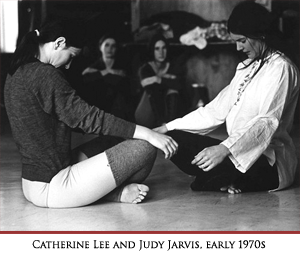 | ||||||||
September 11, 1968 -- Frosh Week: A really great talent show. There was a dancer -- Miss Jarvis who was fantastic. She, I think, is my answer. I have found what I have been looking for. She was so beautiful. She connected to the Drama Department right away, choreographing a production of Megan Terry's Viet Rock in November of 1968. Judy also started up a Modern Dance Club, which met in the university's gymnasium every Thursday night. Judy's guidance, her complex responsive interest, creative excitement and deep curiosity were exhilarating to the students. She was an inspiring presence, intensely devoted to dance.
I remember the impact of the first class I ever did with her. She had us do an improvisation. This was the turn-around moment. It spoke to me, as my varied training up to then never did, of an entire way of looking at the generation of movement and relationships. I did this improvisation and said "This is home for me." It was very profound. In the summer of 1969 Judy helped Frau Thiele, one of her former teachers at the Wigman School, travel to Canada. Frau Thiele, adrift after Wigman closed her school, was encouraged by Judy's talk of pioneering in Canada. They corresponded, expressing mutual hopes to build a school in Canada and to have Frau Til act as a guide for Judy's creative endeavours. Frau Til came to Canada as a guest several times before she emigrated early in 1971. At the Kingston Memorial Hall, Judy and Frau Thiele taught a summer course from July 7 - August 29, 1969. Judy choreographed Missa Luba, a glorious mass sung by choirs of African children and Janko Jesovek, a German composer and accompanist from the Wigman school, came over to work on a piece with Judy. After two years of teaching and solo performance, Judy moved on from Queen's. She had accepted a teaching job in 1970 from the University of Waterloo, where a fledgling dance department was taking root through the Faculty of Kinesiology and Recreation. The initiation of the Waterloo Dance Department was spearheaded by Ruth Priddle, an acquaintance of Judy's from her University of Toronto days. Although Jarvis and Priddle had very different personalities and dance interests, they shared a passionate commitment to building a unique centre for dance study. For seven consecutive school years, on two days of the week, Judy would commute to Waterloo from Toronto and for a time from New York. She taught several levels of modern dance technique and composition and she also set new and old works on the student company. The programme was small. Judy gathered a nucleus. All of us got the most extreme benefit of her creativity. Everything had to do with dance and nothing else mattered. She became like a guru. In New York she taped hours of the Krishnas on the street chanting. Then she taught us these amazing technique classes consisting only of cross-floor work but including all the technical things you would normally do at the barre and in the centre. Without really ever stopping we would travel across the floor to an hour and a half of chanting! They were wonderful classes. Judy excelled as a teacher and was particularly successful in enabling her students to connect their own creative voices with their moving bodies. Her popular composition and improvisation classes were fun and intellectually stimulating. She opened many a creative door for her students. ... If I were a painter, I would never teach anyone how I painted a specific picture, because it's my personal expression of life. I would, I hope, teach that student how to make his own picture.
Inevitably in her improvisation and composition classes she would introduce themes that she was exploring in her own choreographic work. In this way she was able to get the most mileage out of simultaneous careers as a teacher and choreographer. One was fodder for the other. (Next Page) ©2005, Dance Collection Danse | ||
 Judy returned from Berlin in 1967 to take up her performing and teaching career in Canada. She had accepted a job offer from Queen's University to teach dance in the Physical Education Faculty, a position which would pay her $6000 for the academic year. She became essentially an artist-in-residence.
Judy returned from Berlin in 1967 to take up her performing and teaching career in Canada. She had accepted a job offer from Queen's University to teach dance in the Physical Education Faculty, a position which would pay her $6000 for the academic year. She became essentially an artist-in-residence.


